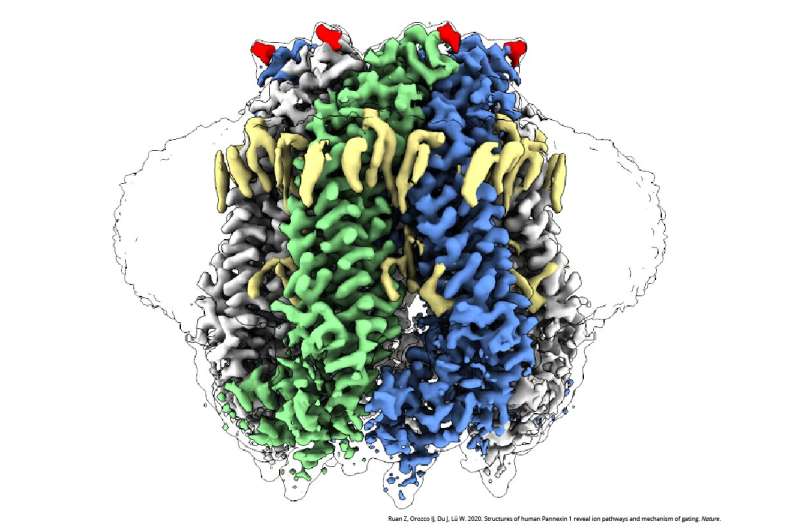A cryo-EM image of PANX1. Credit: Dr. Wei Lu and Dr. Juan Du, Van Andel Institute
Van Andel Institute scientists have for the first time described the near-atomic level structure of a molecular pathway that plays critical roles in human development, blood pressure regulation, inflammation and cell death. The findings were published today in the journal Nature.
"The pannexin1 channel, or PANX1, is vitally important for maintaining normal, healthy function and, as such, is a major target for treating a host of diseases," said Wei Lü, Ph.D., an assistant professor in Van Andel Institute's Structural Biology Program and co-corresponding author of the study. "Our new images provide a blueprint for drug development and also answer longstanding questions about how PANX1 works."
PANX1 is a protein that is present in tissues throughout the body, where it forms channels that allow the passage of molecules such as the cellular fuel ATP, along with much smaller ions. Drugs that interfere with PANX1 have shown promise as therapies for a number of diseases, including cardiovascular diseases and cancer. Until now, little was known about how exactly these agents interact with PANX1.
The study revealed key changes in PANX1 during normal conditions versus times when the cells are undergoing apoptosis, a process that recycles damaged and dead cells. These variations cause molecules and ions to be routed through different areas of the channel and determine whether a large pore is open or closed.
The pannexin1 channel, or PANX1, plays critical roles in human development, blood pressure regulation, inflammation and cell death. Its structure has been visualized at the near-atomic level using cryo-electron microscopy. Credit: Dr. Wei Lu and Dr. Juan Du, Van Andel Institute.
Under normal conditions, the pore is blocked, and only small ions are allowed through seven narrow side tunnels in PANX1. However, during apoptosis, the pore is opened and ATP is released, which sends a signal that kicks off cellular recycling.
Importantly, the team also determined that a common medication that inhibits PANX1, carbenoxolone, works by preventing other molecules from entering the channel. Carbenoxolone is used to treat ulcers and is being investigated as a therapy for several cancers.
"These insights will be impactful beyond our understanding of PANX1—they also shed light on how other similar large-pore channels function," said Juan Du, Ph.D., an assistant professor in VAI's Structural Biology Program and co-corresponding author of the study.
In addition to Du and Lü, authors include lead author Zheng Ruan, Ph.D., and Ian J. Orozco, Ph.D., of VAI. The findings were made possible by VAI's state-of-the-art David Van Andel Advanced Cryo-Electron Microscopy Suite, which allows scientists to view some of life's smallest components in exquisite detail. VAI's most powerful microscope, the Titan Krios, can visualize molecules 1/10,000th the width of a human hair. The high-performance computing team at VAI also provided support for this work.
More information: Zheng Ruan et al, Structures of human pannexin 1 reveal ion pathways and mechanism of gating, Nature (2020). DOI: 10.1038/s41586-020-2357-y
Journal information: Nature
Provided by Van Andel Research Institute
























